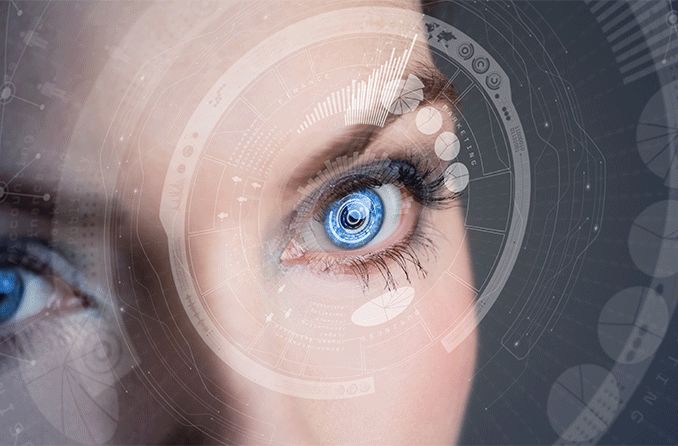Apple AR contact lenses: Rumor or 'virtual' reality?

Apple, the world’s most valuable tech company and creator of some of the world’s most popular electronic devices, appears to have its eye on the emerging frontier of smart contact lenses.
MacRumors, a website that reports news about Apple, cites a research report from tech analyst Ming-Chi Kuo predicting Apple will unveil augmented reality contact lenses sometime in the 2030s. MacRumors notes, however, that since there are no concrete details about the potential Apple lenses, Kuo’s speculation “sounds more like a moonshot prediction rather than a guaranteed product.”
Smart contact lenses featuring augmented reality technology hold the potential for what Kuo and others call “invisible computing.”
As MacRumors explains, “Apple’s contact lenses could provide a lightweight augmented reality experience without the need to wear glasses or a headset. In simple terms, augmented reality overlays digital information over a real-world view; for example, a person walking in an outdoor shopping plaza could easily view each store’s hours of operation.”
Mojo Vision developing smart contact lenses
Even if the rumors are true, Apple lags behind other tech companies in developing contact lenses equipped with augmented reality (AR) capabilities. One of the leaders in this field is a company called Mojo Vision.
In January 2020, Mojo Vision revealed it was working on AR contact lenses. The Mojo Lens features a built-in display that relays visual information to the wearer without needing to glance at a screen and without being distracted by their surroundings.
The Mojo contacts incorporate micro-displays, wireless radios, image sensors and motion sensors, according to IEEE Spectrum, the flagship publication of the IEEE engineering organization.
The U.S. Food and Drug Administration (FDA) has designated the Mojo Lens as a “breakthrough device.” This means the smart contact lenses should gain quicker-than-normal FDA approval. Aside from the FDA, Mojo’s lenses are getting a boost from NASA: The lenses may help astronauts with visual tasks as they explore the moon or Mars.
Mojo anticipates its AR contacts will particularly aid people with low or impaired vision as they go about day-to-day activities like crossing the street, figuring out where to enter a building and navigating unfamiliar places.
Mojo’s smart contact lenses aren’t available for sale yet.
“If you don't suffer from low vision, have a seat. If it takes a few years to get clearance on a device that works for the visually impaired, it will take a few more to make a smart contact lens for everyone else,” Wired magazine points out.
InWith Corp. stakes its claim in the smart contact lens market
One of Mojo’s chief rivals in the race to develop AR contact lenses is InWith Corp.
At this year’s CES, the world’s largest showcase for consumer electronics, InWith showed off a method for placing chips on regular soft contact lenses to convert them into AR contacts. InWith’s technology isn’t available to the public yet.
Among other uses, people with myopia (nearsightedness) or hyperopia (farsightedness) someday could wear the lenses to improve their vision, InWith says. As explained by Forbes, the InWith contacts “harvest energy from the normal blinking of the eyes,” paving the way to check the wearer’s blood sugar level, send alerts and notifications, dispense drugs and much more.
The future of smart contact lenses
Mojo Vision and InWith are two of the key players in the market for smart contact lenses. According to one forecast, the global market for augmented reality and virtual reality contact lenses will reach $1.74 billion by 2026.
Augmented reality and virtual reality aren’t the only innovations in smart contacts, though. For instance, researchers at Japan’s Tohoku University reported in January 2020 that they’ve developed smart contacts designed to treat dry eye syndrome. The contacts’ self-moisturizing technology maintains a layer of fluid between the lens and the eye.
“Although there have been many recent advancements in new functions for smart contact lenses, there has been little progress in solving the drawbacks associated with wearing contact lenses day to day,” says Matsuhiko Nishizawa, an engineering professor at Tohoku University.
READ NEXT: What’s happening with Apple Glasses?
The 10 most valuable tech companies in the world. (September 2020). U.S. News & World Report.
Kuo: Apple may release augmented reality contact lenses in 2030s. (March 2021). MacRumors.
Mojo Vision developing first true smart contact lens. (January 2020). Mojo Vision.
Augmented reality in a contact lens: It’s the real deal. (January 2020). IEEE Spectrum.
About IEEE Spectrum. (March 2021). IEEE Spectrum.
Mojo Vision working with FDA, nonprofit organization to assist people with low vision. (January 2020). Business Wire.
Mojo Vision named winner in NASA iTech 2020 cycle I. (October 2020). Mojo Vision.
The display of the future might be in your contact lens. (January 2020). Wired.
The future of vision: Augmented reality contact lenses will make you bionic. (March 2021). Digital Trends.
CES, the world’s largest tech conference, will be online-only in 2021. (July 2020). The Verge.
InWith premiers the future of electronic contact lenses at CES 2021. (January 2021). PR Newswire.
Myopia (nearsightedness): causes, treatment. (February 2021). All About Vision.
Presbyopia: What causes it and how to treat it. (March 2021). All About Vision.
InWith puts smart tech In Bausch and Lomb lenses. (March 2020). Forbes.
Technology and trends 2017 to 2026. (March 2021). KSU | The Sentinel Newspaper.
Self-moisturizing smart contact lenses. (January 2020). ScienceDaily.
Tohoku University. (March 2021). Tohoku University.
Page published on Friday, March 12, 2021




